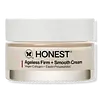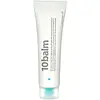What's inside
What's inside
 Key Ingredients
Key Ingredients

 Benefits
Benefits

 Concerns
Concerns

 Ingredients Side-by-side
Ingredients Side-by-side

Water
Skin ConditioningHelianthus Annuus Seed Oil
EmollientBrassica Alcohol
EmollientGlycerin
HumectantIsostearyl Hydroxystearate
EmollientCaprylic/Capric Triglyceride
MaskingButyrospermum Parkii Butter
Skin ConditioningCetyl Alcohol
EmollientCetearyl Olivate
Sorbitan Olivate
EmulsifyingPropanediol
SolventDimethicone
EmollientMagnesium Aluminum Silicate
AbsorbentSh-Polypeptide-121
Skin ConditioningSh-Polypeptide-50
Skin ConditioningHydrolyzed Sodium Hyaluronate
Skin ConditioningSodium Acetylated Hyaluronate
HumectantSaccharomyces/Sugarcane Juice Extract Ferment Extract
Skin ConditioningThymus Vulgaris Flower/Leaf Extract
MaskingXanthan Gum
EmulsifyingLecithin
EmollientTocopherol
AntioxidantXylitol
HumectantCetyl Palmitate
EmollientSorbitan Palmitate
EmulsifyingCaprylic Acid
CleansingMyristyl Alcohol
EmollientStearyl Alcohol
EmollientLauryl Alcohol
Emollient1,2-Hexanediol
Skin ConditioningCaprylhydroxamic Acid
Isostearyl Alcohol
EmollientHydroxystearic Acid
CleansingCitric Acid
BufferingTrisodium Ethylenediamine Disuccinate
Potassium Sorbate
PreservativeSodium Benzoate
MaskingWater, Helianthus Annuus Seed Oil, Brassica Alcohol, Glycerin, Isostearyl Hydroxystearate, Caprylic/Capric Triglyceride, Butyrospermum Parkii Butter, Cetyl Alcohol, Cetearyl Olivate, Sorbitan Olivate, Propanediol, Dimethicone, Magnesium Aluminum Silicate, Sh-Polypeptide-121, Sh-Polypeptide-50, Hydrolyzed Sodium Hyaluronate, Sodium Acetylated Hyaluronate, Saccharomyces/Sugarcane Juice Extract Ferment Extract, Thymus Vulgaris Flower/Leaf Extract, Xanthan Gum, Lecithin, Tocopherol, Xylitol, Cetyl Palmitate, Sorbitan Palmitate, Caprylic Acid, Myristyl Alcohol, Stearyl Alcohol, Lauryl Alcohol, 1,2-Hexanediol, Caprylhydroxamic Acid, Isostearyl Alcohol, Hydroxystearic Acid, Citric Acid, Trisodium Ethylenediamine Disuccinate, Potassium Sorbate, Sodium Benzoate
Water
Skin ConditioningGlycerin
HumectantGlycine Soja Oil
EmollientSimmondsia Chinensis Seed Oil
EmollientCaprylic/Capric Triglyceride
MaskingCetearyl Olivate
Sorbitan Olivate
EmulsifyingAdansonia Digitata Seed Oil
EmollientCetyl Alcohol
EmollientDimethicone
EmollientMyristyl Alcohol
EmollientCetyl Palmitate
EmollientHoney Extract
HumectantMauritia Flexuosa Fruit Oil
Skin ConditioningSorbitan Palmitate
EmulsifyingPollen Extract
EmollientPropolis Extract
Skin ConditioningRoyal Jelly Extract
Skin ConditioningMyristyl Glucoside
CleansingXanthan Gum
EmulsifyingAllantoin
Skin ConditioningBisabolol
MaskingArnica Montana Flower Extract
MaskingPEG-40 Hydrogenated Castor Oil
EmulsifyingDisodium EDTA
Tocopherol
AntioxidantGlucose
HumectantCaprylyl Glycol
EmollientPhenoxyethanol
PreservativeWater, Glycerin, Glycine Soja Oil, Simmondsia Chinensis Seed Oil, Caprylic/Capric Triglyceride, Cetearyl Olivate, Sorbitan Olivate, Adansonia Digitata Seed Oil, Cetyl Alcohol, Dimethicone, Myristyl Alcohol, Cetyl Palmitate, Honey Extract, Mauritia Flexuosa Fruit Oil, Sorbitan Palmitate, Pollen Extract, Propolis Extract, Royal Jelly Extract, Myristyl Glucoside, Xanthan Gum, Allantoin, Bisabolol, Arnica Montana Flower Extract, PEG-40 Hydrogenated Castor Oil, Disodium EDTA, Tocopherol, Glucose, Caprylyl Glycol, Phenoxyethanol
Ingredients Explained
These ingredients are found in both products.
Ingredients higher up in an ingredient list are typically present in a larger amount.
This ingredient is an emollient, solvent, and texture enhancer. It is considered a skin-softener by helping the skin prevent moisture loss.
It helps thicken a product's formula and makes it easier to spread by dissolving clumping compounds.
Caprylic Triglyceride is made by combining glycerin with coconut oil, forming a clear liquid.
While there is an assumption Caprylic Triglyceride can clog pores due to it being derived from coconut oil, there is no research supporting this.
Learn more about Caprylic/Capric TriglycerideCetearyl Olivate is an emulsifier and texture enhancer. It is derived from the fatty acids of olive oil and Cetearyl alcohol, and is biodegradable.
As an emulsifier, it is used to prevent oils and waters from separating. It can also
Manufacturers use the name Olivem 1000. This ingredient has been found to preserve the natural microbiome of skin. Having a healthy microbiome helps keep our skin healthy and protects against harmful bacteria. This ingredient is grouped with Sorbitan Olivate under the name Olivem 1000.
Learn more about Cetearyl OlivateCetyl Alcohol is a fatty alcohol. Fatty Alcohols are most often used as an emollient or to thicken a product.
Its main roles are:
Though it has "alcohol" in the name, it is not related to denatured alcohol or ethyl alcohol.
The FDA allows products labeled "alcohol-free" to have fatty alcohols.
Learn more about Cetyl AlcoholCetyl Palmitate is a wax-like substance.
It comes from palmitic acid and palmityl alcohol. Cetyl Palmitate may not be safe for Malassezia folliculitis, or fungal-acne.
This ingredient is naturally found in the guava fruit and stony corals.
Learn more about Cetyl PalmitateDimethicone is a type of synthetic silicone created from natural materials such as quartz.
What it does:
Dimethicone comes in different viscosities:
Depending on the viscosity, dimethicone has different properties.
Ingredients lists don't always show which type is used, so we recommend reaching out to the brand if you have questions about the viscosity.
This ingredient is unlikely to cause irritation because it does not get absorbed into skin. However, people with silicone allergies should be careful about using this ingredient.
Note: Dimethicone may contribute to pilling. This is because it is not oil or water soluble, so pilling may occur when layered with products. When mixed with heavy oils in a formula, the outcome is also quite greasy.
Learn more about DimethiconeGlycerin is already naturally found in your skin. It helps moisturize and protect your skin.
A study from 2016 found glycerin to be more effective as a humectant than AHAs and hyaluronic acid.
As a humectant, it helps the skin stay hydrated by pulling moisture to your skin. The low molecular weight of glycerin allows it to pull moisture into the deeper layers of your skin.
Hydrated skin improves your skin barrier; Your skin barrier helps protect against irritants and bacteria.
Glycerin has also been found to have antimicrobial and antiviral properties. Due to these properties, glycerin is often used in wound and burn treatments.
In cosmetics, glycerin is usually derived from plants such as soybean or palm. However, it can also be sourced from animals, such as tallow or animal fat.
This ingredient is organic, colorless, odorless, and non-toxic.
Glycerin is the name for this ingredient in American English. British English uses Glycerol/Glycerine.
Learn more about GlycerinMyristyl Alcohol is type of fatty alcohol. It is a white, waxy solid and insoluble in water.
As an emollient, it hydrates the skin by trapping moisture in.
Fatty Alcohols are most often used as an emollient or to thicken a product. They are usually derived from natural fats and oils and therefore do not have the same drying or irritating effect as solvent alcohols.
Learn more about Myristyl AlcoholSorbitan Olivate is created from the fatty acids in olive oil and sorbitol.
This ingredient is an oil in water emulsifier. It helps stabilize a product by preventing oils and waters from separating. Sorbitan Olivate also helps hydrate the skin.
Manufacturers sell sorbitan olivate under the name OliveM 1000. OliveM 1000 a multifunctional ingredient. It is self-emulsifying. According to a manufacturer, OliveM 1000 does not disrupt natural skin biome.
Due to its olive oil base, this ingredient may not be fungal-acne safe.
Learn more about Sorbitan OlivateSorbitan Palmitate is an emulsifier.
It is created by reacting sorbitol with palmitic acid.
Tocopherol (also known as Vitamin E) is a common antioxidant used to help protect the skin from free-radicals and strengthen the skin barrier. It's also fat soluble - this means our skin is great at absorbing it.
Vitamin E also helps keep your natural skin lipids healthy. Your lipid skin barrier naturally consists of lipids, ceramides, and fatty acids. Vitamin E offers extra protection for your skin’s lipid barrier, keeping your skin healthy and nourished.
Another benefit is a bit of UV protection. Vitamin E helps reduce the damage caused by UVB rays. (It should not replace your sunscreen). Combining it with Vitamin C can decrease sunburned cells and hyperpigmentation after UV exposure.
You might have noticed Vitamin E + C often paired together. This is because it is great at stabilizing Vitamin C. Using the two together helps increase the effectiveness of both ingredients.
There are often claims that Vitamin E can reduce/prevent scarring, but these claims haven't been confirmed by scientific research.
Learn more about TocopherolWater. It's the most common cosmetic ingredient of all. You'll usually see it at the top of ingredient lists, meaning that it makes up the largest part of the product.
So why is it so popular? Water most often acts as a solvent - this means that it helps dissolve other ingredients into the formulation.
You'll also recognize water as that liquid we all need to stay alive. If you see this, drink a glass of water. Stay hydrated!
Learn more about WaterXanthan gum is used as a stabilizer and thickener within cosmetic products. It helps give products a sticky, thick feeling - preventing them from being too runny.
On the technical side of things, xanthan gum is a polysaccharide - a combination consisting of multiple sugar molecules bonded together.
Xanthan gum is a pretty common and great ingredient. It is a natural, non-toxic, non-irritating ingredient that is also commonly used in food products.
Learn more about Xanthan Gum